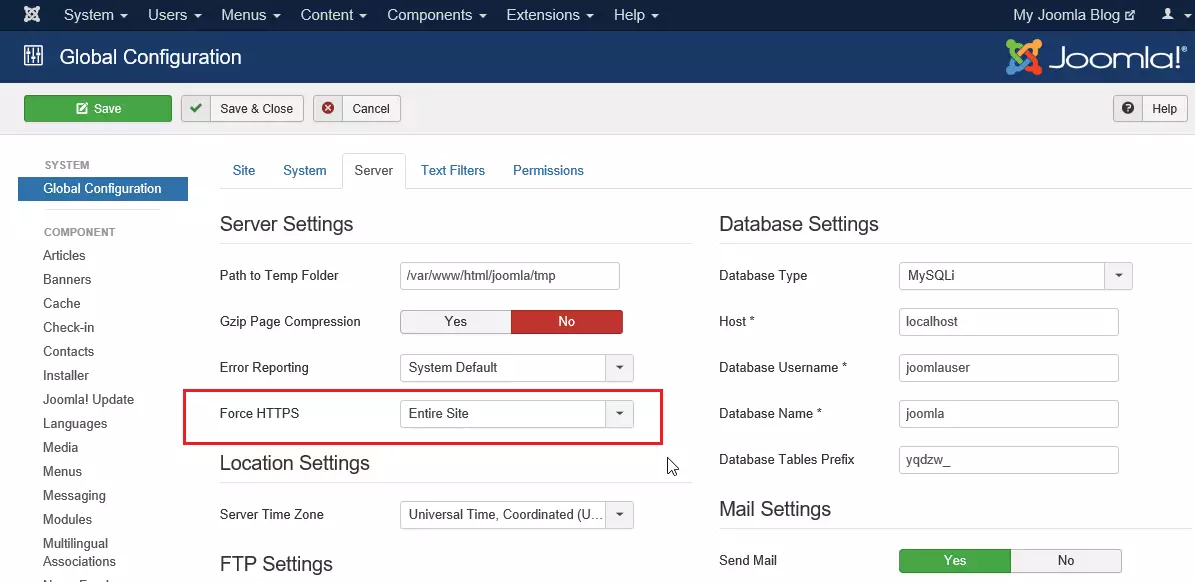This article explains switching to HTTPS in Joomla CMS with Apache on Ubuntu Linux.
Switching to HTTPS on Joomla provides a secure connection between the website and the user’s browser, ensuring that data is not intercepted or tampered with by third parties.
HTTPS also helps to establish trust with website visitors by displaying a padlock icon in the browser’s address bar and the “Secure” label. Additionally, search engines like Google prioritize websites that use HTTPS over those that don’t, which can help improve search engine rankings.
This brief tutorial will show students and new users how to easily convert existing Joomla websites from HTTP to HTTPS without losing your audience.
Setup Let’s Encrypt Free SSL / TLS
The first step in all HTTPS is obtaining SSL/TLS certificates for your domain or site. Since Let’s Encrypt is free, continue below to receive free certificates.
Before obtaining Let’s Encrypt certificates, ensure your Apache2 configuration is set up correctly. For example, ensure your site config file defines the ServerName and ServerAlias.
<VirtualHost *:80>
ServerAdmin [email protected]
DocumentRoot /var/www/html/joomla/
ServerName example.com
ServerAlias www.example.com
.
.
When those settings are confirmed, continue below to get the certificate for your domain name.
To get the Let’s Encrypt SSL/TLS client installed on Ubuntu, run the commands below
sudo apt-get install python-certbot-apache
After that, run the commands below to obtain your site’s free Let’s Encrypt SSL/TLS certificate.
sudo certbot --apache -m [email protected] -d example.com -d www.example.com
After running the above commands, you should be prompted to accept the licensing terms. If everything is checked, the client should automatically install the free SSL/TLS certificate and configure the Nginx site to use the certs.
Please read the Terms of Service at
https://letsencrypt.org/documents/LE-SA-v1.2-November-15-2017.pdf. You must
agree in order to register with the ACME server at
https://acme-v01.api.letsencrypt.org/directory
-------------------------------------------------------------------------------
(A)gree/(C)ancel: A
Choose Yes ( Y ) to share your email address.
Would you be willing to share your email address with the Electronic Frontier
Foundation, a founding partner of the Let's Encrypt project and the non-profit
organization that develops Certbot? We'd like to send you email about EFF and
our work to encrypt the web, protect its users and defend digital rights.
-------------------------------------------------------------------------------
(Y)es/(N)o: Y
This is how easy it is to obtain your free SSL/TLS certificate for your Nginx-powered website.
Please choose whether or not to redirect HTTP traffic to HTTPS, removing HTTP access. ------------------------------------------------------------------------------- 1: No redirect - Make no further changes to the webserver configuration. 2: Redirect - Make all requests redirect to secure HTTPS access. Choose this for new sites, or if you're confident your site works on HTTPS. You can undo this change by editing your web server's configuration. ------------------------------------------------------------------------------- Select the appropriate number [1-2] then [enter] (press 'c' to cancel): 2
Pick option 2 to redirect all traffic over HTTPS. This is important!
After that, the SSL client should install the cert and configure your website to redirect all traffic over HTTPS.
Congratulations! You have successfully enabled https://example.com and https://www.example.com You should test your configuration at: https://www.ssllabs.com/ssltest/analyze.html?d=example.com https://www.ssllabs.com/ssltest/analyze.html?d=www.example.com ------------------------------------------------------------------------------- IMPORTANT NOTES: - Congratulations! Your certificate and chain have been saved at: /etc/letsencrypt/live/example.com/fullchain.pem Your key file has been saved at: /etc/letsencrypt/live/example.com/privkey.pem Your cert will expire on 2018-02-24. To obtain a new or tweaked version of this certificate in the future, simply run certbot again with the "certonly" option. To non-interactively renew *all* of your certificates, run "certbot renew" - If you like Certbot, please consider supporting our work by: Donating to ISRG / Let's Encrypt: https://letsencrypt.org/donate Donating to EFF: https://eff.org/donate-le
The highlighted code block should automatically be added to your Apache2 Joomla configuration file by Let’s Encrypt certbot. After that, your Joomla site is ready to be used over HTTPS.
<VirtualHost *:80> ServerAdmin [email protected] DocumentRoot /var/www/html/joomla/ ServerName example.com ServerAlias www.example.com <Directory /var/www/html/joomla/> Options +FollowSymlinks AllowOverride All Require all granted </Directory> ErrorLog ${APACHE_LOG_DIR}/error.log CustomLog ${APACHE_LOG_DIR}/access.log combined RewriteEngine on RewriteCond %{SERVER_NAME} =example.com [OR] RewriteCond %{SERVER_NAME} =www.example.com RewriteRule ^ https://%{SERVER_NAME}%{REQUEST_URI} [END,NE,R=permanent] </VirtualHost>
A new configuration file for the domain should also be created named /etc/apache2/sites-available/example-le-ssl.conf. This Apache2 SSL module configuration file should contain defined certificate definitions.
<IfModule mod_ssl.c>
<VirtualHost *:443>
ServerAdmin [email protected]
DocumentRoot /var/www/html/joomla/
ServerName example.com
ServerAlias www.example.com
<Directory /var/www/html/joomla/>
Options +FollowSymlinks
AllowOverride All
Require all granted
</Directory>
ErrorLog ${APACHE_LOG_DIR}/error.log
CustomLog ${APACHE_LOG_DIR}/access.log combined
SSLCertificateFile /etc/letsencrypt/live/example.com/fullchain.pem
SSLCertificateKeyFile /etc/letsencrypt/live/example.com/privkey.pem
Include /etc/letsencrypt/options-ssl-apache.conf
</VirtualHost>
</IfModule>
Change the Joomla Site URL
After configuring Apache2 to use HTTPS above, change the Joomla site URL to HTTPS. This can be done by editing the configuration.php file in your Joomla root directory.
sudo nano /var/www/html/example.com/configuration.php
Open the Joomla configuration.php file in your Joomla root directory and add or edit the lines below:
?php
//Use HTTPS for Joomla
var $live_site = 'https://example.com';
Save the file
Now, you can log on to the Joomla admin dashboard via HTTPS.
Force HTTPS for the Entire Site
Finally, log on to the Joomla dashboard, navigate to System ==> Global Configuration ==> Server, and force HTTPS for the entire site.

When you’re done, your Joomla site should be HTTPS compliant.
This should do it.
After that, your site should be HTTPS compliant.
Congratulations! You’ve successfully converted from HTTP to HTTPS
To set up a process to automatically renew the certificates, add a cron job to execute the renewal process.
sudo crontab -e
Then add the line below and save.
0 1 * * * /usr/bin/certbot renew & > /dev/null
The cron job will attempt to renew 30 days before expiring
You may also like the post below:

Leave a Reply